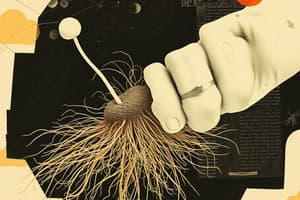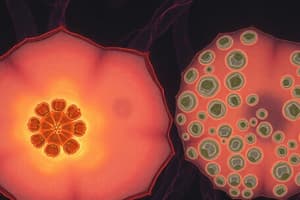Podcast
Questions and Answers
What is the primary difference between active transport and diffusion?
What is the primary difference between active transport and diffusion?
- Active transport moves particles against the concentration gradient using energy. (correct)
- Diffusion requires energy, while active transport does not.
- Active transport moves particles from high to low concentration.
- Diffusion uses protein channels, while active transport does not.
Active transport in root hairs is used to take up water from the soil.
Active transport in root hairs is used to take up water from the soil.
False (B)
What type of energy is used in active transport?
What type of energy is used in active transport?
energy from respiration
In the gut, active transport moves glucose and amino acids from the gut into the ______.
In the gut, active transport moves glucose and amino acids from the gut into the ______.
Match the locations of active transport with their purpose:
Match the locations of active transport with their purpose:
Flashcards
Active Transport
Active Transport
Movement of molecules from an area of low concentration to an area of high concentration. This process requires energy from respiration.
Root Hairs
Root Hairs
Tiny hair-like structures on plant roots that absorb water and mineral ions from the soil.
Concentration Gradient
Concentration Gradient
The difference in concentration of a substance between two areas. Diffusion moves substances down the concentration gradient.
Respiration
Respiration
Signup and view all the flashcards
Active Transport in the Gut
Active Transport in the Gut
Signup and view all the flashcards
Study Notes
Active Transport (1.3.3)
-
Active transport moves particles from a low concentration area to a high concentration area, against the concentration gradient. This contrasts with passive diffusion. Active transport requires energy.
-
Active transport is fueled by respiration.
In Root Hairs
-
Plants use active transport to absorb water and mineral ions from the soil for growth.
-
Mineral ions are often present in higher concentrations inside the root hair cells than in the soil. Therefore, diffusion wouldn't work. Active transport is necessary against the concentration gradient.
Active Transport in the Gut
-
Active transport moves substances like glucose and amino acids from the digestive tract (gut) to the bloodstream.
-
Sometimes the concentration of dissolved substances (e.g., sugar) in the gut is lower than in the blood. In such instances, the concentration gradient would not drive diffusion into the blood; hence, active transport is needed.
Studying That Suits You
Use AI to generate personalized quizzes and flashcards to suit your learning preferences.




